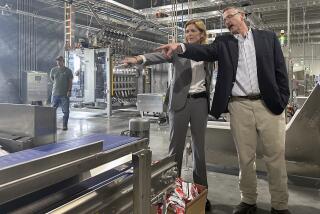Technique Strengthens Bridges : Earthquakes: The new ‘edge beam’ method can be used on more than 1,000 spans that could collapse in a major temblor, researchers say.
UC San Diego engineers have developed a revolutionary bridge-strengthening technique that can be used to retrofit more than 1,000 California bridges that are vulnerable to earthquake damage, state officials announced Thursday.
The technology grew out of research funded after the 1989 Loma Prieta Earthquake in the San Francisco Bay Area and is designed to avert disasters like the collapse of a mile-long stretch of the Nimitz Freeway, which killed 42 people.
Pending final tests next month, the technique is expected to be used on U.S. 101 and Interstate 280 viaducts in San Francisco that have been closed because of earthquake damage, said Jim Roberts, chief of Caltrans’ division of structures.
Because the preliminary test results have been overwhelmingly positive, Caltrans officials believe this will also serve as an option for double-column and double-deck bridges across the nation.
The new “edge beam” concept features a beam supported by circular columns running along the outside of the structure. Scientists tout the new design as being flexible enough to bend in a major earthquake and durable enough to withstand the force.
The concept is considered revolutionary because it puts together all that is known about circular columns, modified hinges and retrofitted joints and beams. And for the first time, engineers will test the technique in a simulated earthquake before installing it.
“By simulating earthquake stresses in the lab, we can then apply these technologies to the real-world freeways and bridges we all drive every day,” said Kyle Nelson, a Caltrans spokesman. “It’s revolutionary and it has applications worldwide.”
M.J. Nigel Priestley, the UC San Diego professor of structural engineering who developed the new retrofit concept, said: “We’ve now made enormous improvements in our understanding of how structures perform and in our ability to design for earthquakes.”
The 1989 earthquake that hit the San Francisco Bay Area dramatically raised the priority of an 18-year-old state program to retrofit roadways for earthquake safety. After the quake, the state Legislature mandated that every bridge, freeway connector, overpass or other type of elevated road structure be examined and--if necessary--fixed by 1994.
After inspecting 24,000 highway bridges across the state, Caltrans engineers identified about 4,000 as potentially “at risk” in the event of a large earthquake.
To pay for costly upgrading, a temporary 0.25-cent sales tax was instituted. That action brought in $80 million. More recently, the retrofitting program has been funded by the new gas tax and state funding.
In their research, UCSD scientists discovered three vulnerable points in older bridges: rectangular columns, deficient beams and lack of flexibility along the length of the roadway.
Priestley and his team developed a retrofit for double-deck and other bridges that uses 8-foot-by-4-foot steel-reinforced concrete “edge beams.” The beams run along the outside of the structure and are supported by circular columns. Under stress, circular columns retain more concrete than their rectangular counterparts, said Frieder Seible, a UCSD professor of structural engineering.
On Aug. 5, UCSD researchers will undertake an unprecedented test of the new retrofiting techniques that they have pioneered. For the test, they will use a half-scale model that has concrete columns 3.3 feet in diameter. The lower column is 10 feet tall; the upper column is 6 feet tall.
During these tests, they will use 13 computer-controlled hydraulic jacks to produce 260,000 pounds of force, or the equivalent of a magnitude 8.0, 60-second earthquake on the San Andreas Fault or a 7.5 temblor on the Hayward Fault.
At a UCSD news conference Thursday at the Charles Lee Powell structural engineering laboratory, Priestley and Seible gave a modest demonstration of the test they intend to run next month, ushering reporters past lines of huge, cracked columns toward two hydraulic jacks.
With the hydraulic jacks jammed up against a narrower column, Priestley explained that the 10-foot concrete column would move five inches.
To the naked eye, however, little seemed to occur. One reporter finally blurted out: “Is it happening yet?”
The results of such a small-scale test, Priestley conceded, are not dramatic. “It’s rather like watching grass grow.”
More to Read
Start your day right
Sign up for Essential California for news, features and recommendations from the L.A. Times and beyond in your inbox six days a week.
You may occasionally receive promotional content from the Los Angeles Times.





